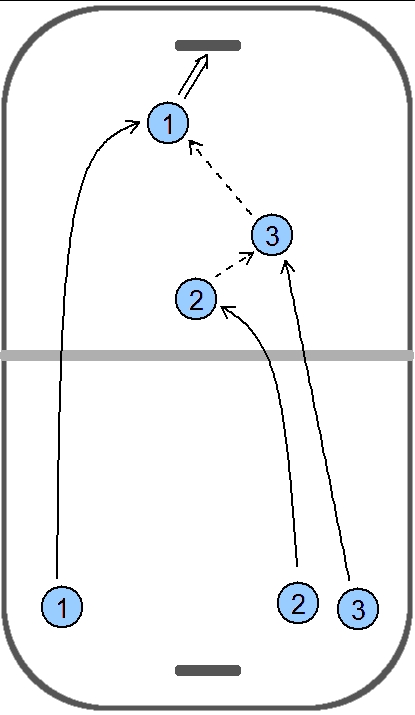Here's the first example, found at 19:15 - a brilliant example of a three up, triangle formation attack.

Players 2 and 3 move up the right side of the court, player 2 controlling the ball. Near the half, he begins to barely circle back towards the left, passing to player 3. After a brief control, he quickly passes to player one, who has crept up the court for a shooting position to the left of the goal.
There are a number of smart plays going on here. First, with three up, the defense is forced to leave one man open to prevent an open goal. Of course, this opens up the possibility of a quick counterattack, which is why player 1's circle back is so key - if the play doesn't work, he's in great position to race back to guard the goal. Player 1 has effectively tied up one defender, and the pass from player 1 to 2 is just enough to draw the attention of the second, leaving the third attacker open. This would have also worked if the defense had chosen to cover the pass instead of attack, because to do so would give an open shot. About the only counter would have been to have two players back and one roving defender, but this strategy makes it very hard to regain control of the ball and begin a drive, and must rely on the other team to mess up.
Basically speaking, triangles are where it's at, offensively. The defense has a tough choice with who to cover, allowing great passing lanes to open up.
The second example can be found at 22:27, just a nice bit of passing that opens up a shot.

This play isn't quite as brilliant as the last, but is still pretty solid because its lines are very atypical. Player 2 is taking the ball up the left side, with player 1 to his left. Instead of continuing up the left board, both players curl to the right, player 1 just a bit behind, ready for the backwards pass. While you can never say for sure what the defense is going to cover, heading back towards the opposite side of the court when you don't have the ball is a good way to shake a defender. Again, if the defender had chose to cover the pass to player 1, it's possible that this could have opened up a shot for player 2. Ultimately, this play didn't result in a goal, but it's definitely a break from the normal, and in another situation, that could be enough to confuse the defense.

No comments:
Post a Comment